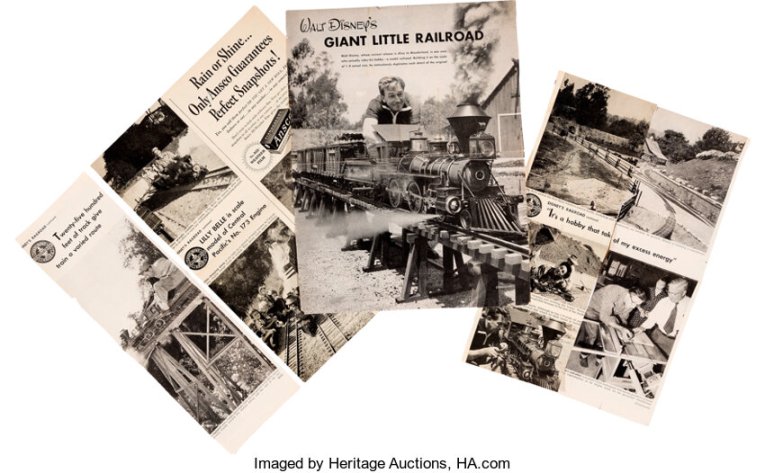
Some lucky Disneyana collector, or hopefully a museum or fan club like The Carolwood Society, will soon be the sole owner of the original plans for Walt Disney’s Backyard Railroad. The historic lot is going up for auction next month on Heritage Auctions.
Walt Disney’s Holmby Hills home, where he lived in the 1950s, was situated on five acres which was the perfect space to indulge in his growing hobby of rideable miniature railroads. He called his backyard hobby the Carolwood Pacific Railroad and in many ways it fueled Walt’s desire to build a special place where others could enjoy trains and other rides as a family.
That germ of an idea eventually grew into Disneyland.
About the Carolwood Railroad
- It featured 2,615 feet of track and a long curving tunnel so you couldn’t see the exit when you entered it.
- The train itself was a perfect 1/8-scale, 260-pound, coal-fueled, 7¼-inch gauge train
- Walt named the locomotive the Lilly Belle in honor of his wife Lillian.
“I just needed something to get myself away from things,” Walt once said of his decision to create this backyard railyard.
The original plans and blueprints are now part of a lot that captures this unique piece of Disney and Los Angeles history. The Heritage Auction event “The Art of the Disney Theme Park and Disney Storybook” will take place April 8-10.

Walt came by his love of trains in his youth. His father Elias once worked as a railroad machinist and carpenter and his uncle Mike Martin was an engineer on the Santa Fe line that rain past Marceline.
When Walt was a little older he worked a summer job as a news butcher on that Santa Fe line. In addition to newspapers, he sold fruit, candy and other snacks and amenities to passengers.
“I felt very important wearing a neat blue serge uniform with brass buttons, a peaked cap and a shiny badge in my lapel,” Disney wrote in the October 1965 issue of Railroad Magazine. “As the train rolled into one station after another I stood beside the conductor on the car steps to enjoy the envious stares of youngsters waiting on the platform.”
Disney’s backyard Carolwood Pacific, with its views of surrounding canyons, may have been miniature, but it was no less real than any life-sized counterpart. Everything about its design and construction was meticulous, from the redwood trestles and rose-garden tunnel to the centralized traffic control board installed in the red barn that served as the Carolwood Pacific’s machine shop and headquarters.

“Walt’s Lilly Belle was a wonderful running engine,” said Ollie Johnston, one of Disney’s most legendary animators and owner of his own backyard rail line. “It had a lot of power.”
Emblematic of Disney’s approach, the Carolwood Pacific was the result of years’ worth of scrupulous research and planning by Disney and his employees Johnston, Ward Kimball and Roger Broggie, the latter the head machinist at the Walt Disney Studios in Burbank.
Every inch of the Lilly Belle, the rolling stock and the rail line is detailed in reams of blueprints and renderings crafted by the colleagues and comrades — the one-day Imagineers — Disney called upon to help make his lifelong fantasy a backyard reality.
Each page echoes Disney’s creative process, with notes, additions, and on-site revisions—many identifiable as by Disney himself and by pioneering Imagineers that would go on from this backyard construction project to turn an orange grove in Anaheim into Disneyland.
So authentic was the endeavor Disney needed Los Angeles city and county officials to sign off on his plans before construction could commence.

“I went about it systematically,” Disney wrote in Railroad Magazine. “After serving an apprenticeship in a machine shop, I studied metalwork and carpentry before I figured I was ready to start building. Then I built a train to one-eighth scale. The engine and the tender combined was seven feet long and operated on coal and water, like the ones I had known as a news butcher. I fashioned all the cars myself. The boxcars were big enough for a person to straddle, and the flatcars could seat two. My special pride was the caboose, which I furnished entirely in miniature, right down to the pot-bellied stove.”
Those planning documents — totaling dozens of pages, many of them grand enough for display as standalone works — have for seven decades remained obscured from the public’s view. Some might have thought them lost altogether, fragile scrolls turned to dust by age or accident.
Yet they survive intact, every inch and instruction behind this railway that would one day blossom into theme parks around the globe. And now, for the first time, this estimable documentation of history — these blueprints, layouts and renderings of the train that led first to a magical kingdom called Disneyland — have become available.
Acquired by the consignor directly from the family of Roger Broggie, Walt’s friend and Imagineer who helped build the Disneyland Railroad, more than 30 years ago, this archive has never before been offered to the public. The timing could not be better, with Disneyland’s reopening scheduled for April 30.
“This archive is a really special insight into something quite extraordinary,” says Jim Lentz, Heritage Auctions’ Director of Animation Art. “These pieces are emblematic of the crossroads that Walt created when he created Disneyland — the creative energy and storytelling that comes from his God-given gift as a creator of characters mashed up with the technical knowhow to do the details right or find the people who know how to make magic happen.”
Preview the entire lot on the HA website.